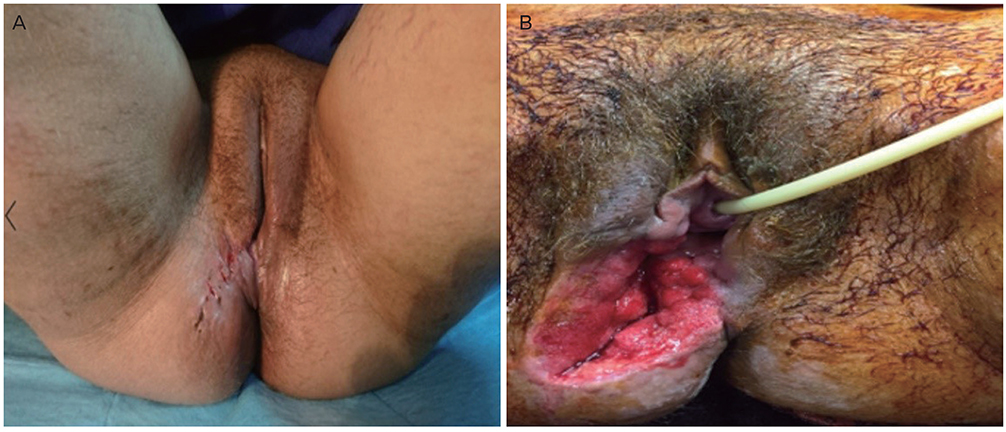Obstet Gynecol Sci.
2019 May;62(3):186-189. 10.5468/ogs.2019.62.3.186.
Use of vacuum-assisted closure in massive puerperal genital hematoma
- Affiliations
-
- 1Department of Gynecology and Obstetrics, Atatürk University School of Medicine, Erzurum, Turkey.
- 2Clinic of Gynecology and Obstetrics, Nenehatun Gynecology and Obstetrics Hospital, Erzurum, Turkey. emr-topdagi@hotmail.com
- KMID: 2445078
- DOI: http://doi.org/10.5468/ogs.2019.62.3.186
Abstract
- Puerperal genital hematomas are rare but life-threatening complications of obstetric emergencies. A pregnant patient (39 weeks) underwent a mediolateral episiotomy during a vaginal delivery. An afterbirth hematoma (approximately 20 cm in diameter) was evacuated, but the use of a vacuum-assisted wound closure system was applied after the sutures opened on the 7th postoperative day. On the 10th day of the vacuum-assisted closure (VAC) application, the wound was completely closed. VAC is an alternative treatment modality that can drain an infection and increase the proportion of granulation tissue in humid and irregular surfaces such as the perineum.
MeSH Terms
Figure
Reference
-
1. İskender C, Topçu HO, Timur H, Oskovi A, Göksu G, Sucak A, et al. Evaluation of risk factors in women with puerperal genital hematomas. J Matern Fetal Neonatal Med. 2016; 29:1435–1439.
Article2. Şenol DK, Aslan E. Perineal assesment after normal birth. J Edu Res Nurs. 2015; 12:7–10.3. Shvartsman HS, Langstein H, Worley C, Malpica A, Ramondetta LM. Use of a vacuum-assisted closure device in the treatment of recurrent Paget's disease of the vulva. Obstet Gynecol. 2003; 102:1163–1166.
Article4. Fleischmann W, Strecker W, Bombelli M, Kinzl L. Vacuum sealing as treatment of soft tissue damage in open fractures. Unfallchirurg. 1993; 96:488–492.5. Argenta LC, Morykwas MJ. Vacuum-assisted closure: a new method for wound control and treatment: clinical experience. Ann Plast Surg. 1997; 38:563–576.6. Morykwas MJ, Argenta LC, Shelton-Brown EI, McGuirt W. Vacuum-assisted closure: a new method for wound control and treatment: animal studies and basic foundation. Ann Plast Surg. 1997; 38:553–562.7. Frykberg RG, Williams DV. Negative-pressure wound therapy and diabetic foot amputations: a retrospective study of payer claims data. J Am Podiatr Med Assoc. 2007; 97:351–359.8. Narducci F, Samouelian V, Marchaudon V, Koenig P, Fournier C, Phalippou J, et al. Vacuum-assisted closure therapy in the management of patients undergoing vulvectomy. Eur J Obstet Gynecol Reprod Biol. 2012; 161:199–201.
Article9. Aviki EM, Batalden RP, del Carmen MG, Berkowitz LR. Vacuum-assisted closure for episiotomy dehiscence. Obstet Gynecol. 2015; 126:530–533.
Article
- Full Text Links
- Actions
-
Cited
- CITED
-
- Close
- Share
- Similar articles
-
- Vacuum-assisted close versus conventional treatment for postlaparotomy wound dehiscence
- A case of secondary postpartum hemorrhage with shock followed by rupture of progressive retroperitoneal hematoma through left upper vaginal wall
- The Treatment of the Foot Ulcer in Hansen's Disease using by Vacuum-Assisted Closure
- Successful Application of Vacuum Assisted Closure in the Case of Neonatal Mediastinitis after Modified Norwood Operation
- Vacuum-Assisted Closure Therapy as an Alternative Treatment of Subcutaneous Emphysema



